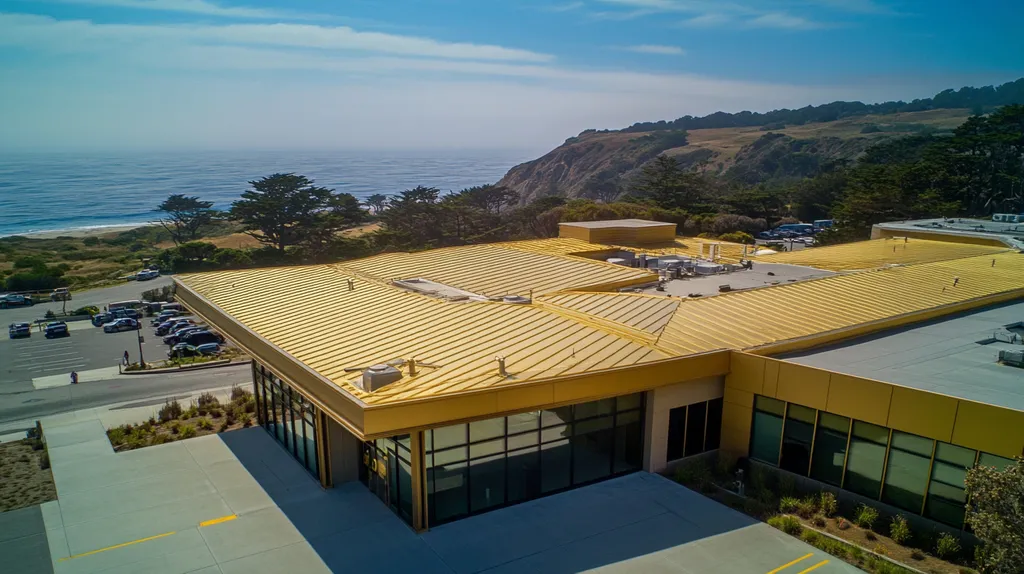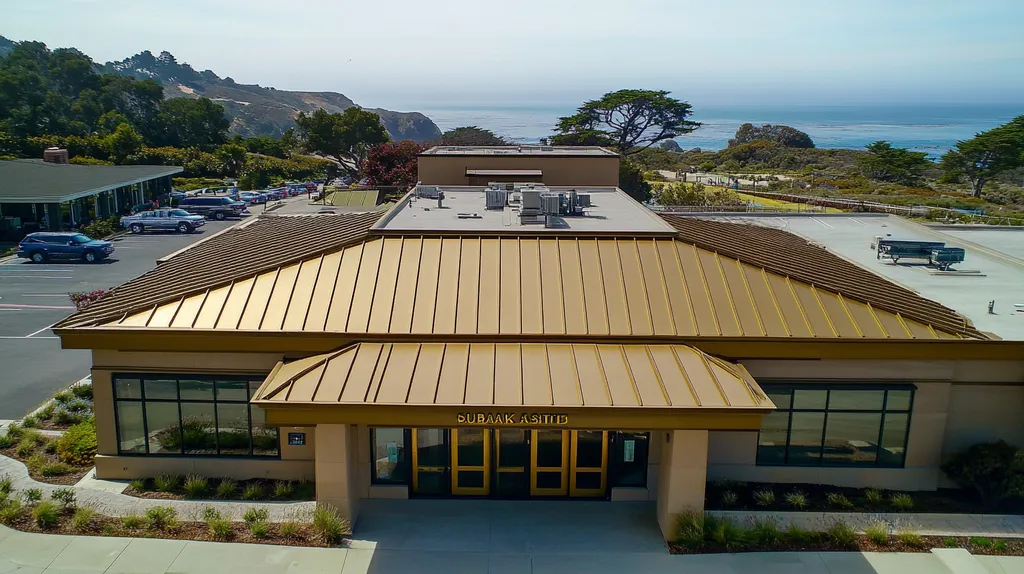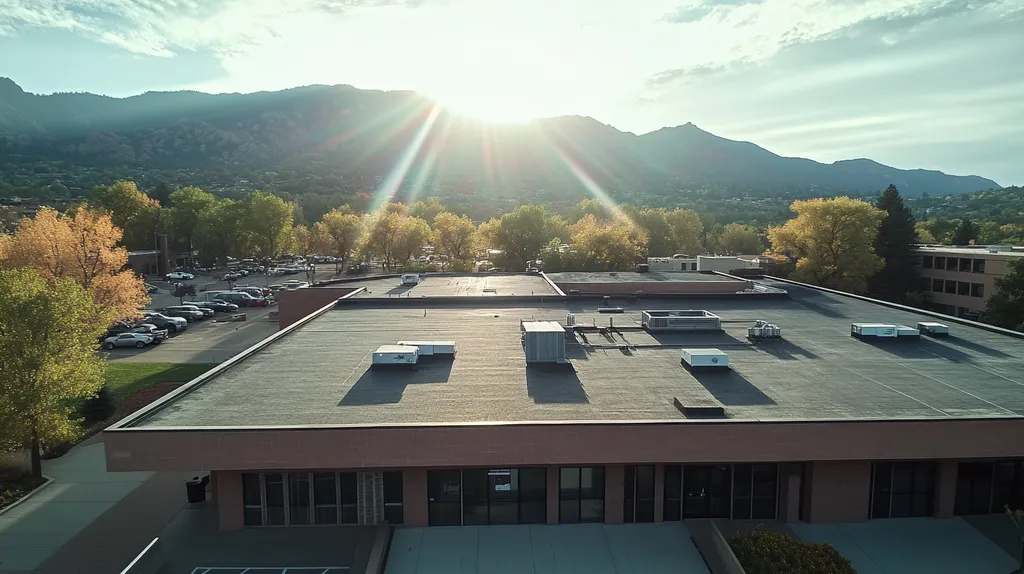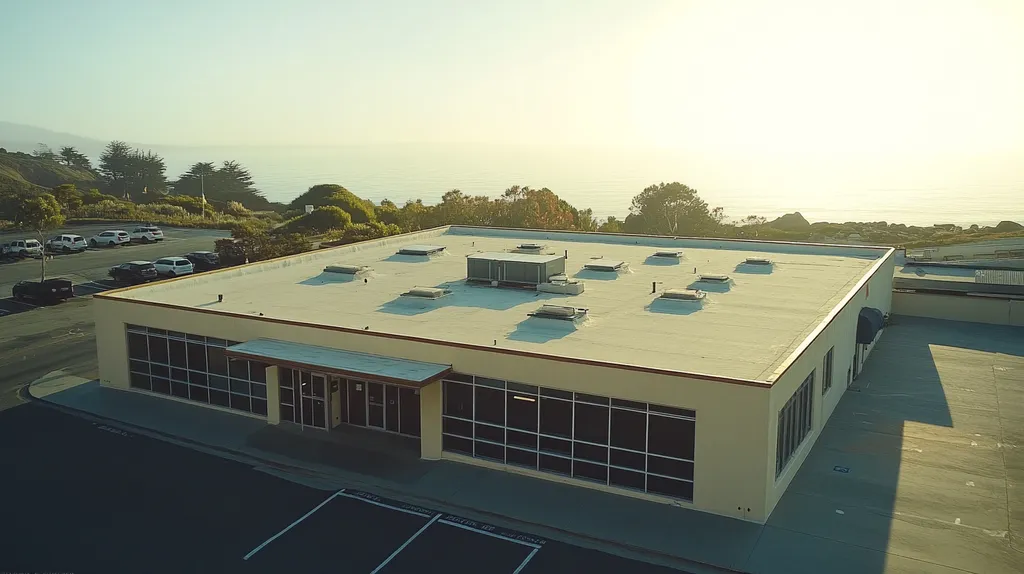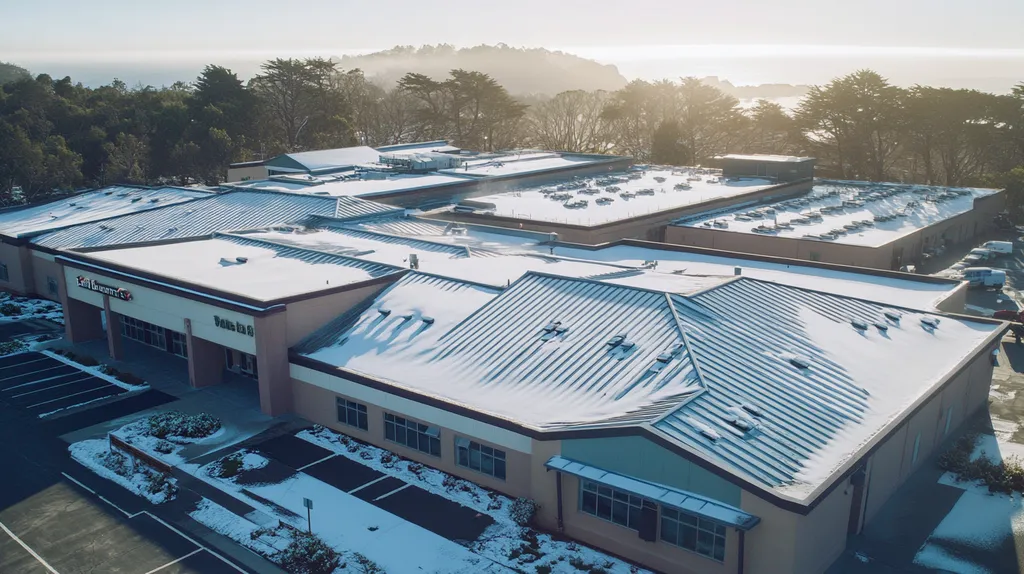Commercial roofing systems represent one of the largest capital investments for any business property, yet studies show that 90% fail prematurely due to preventable causes. The average commercial roof lasts only 15-17 years despite being engineered for a 25-30 year lifespan.
This comprehensive guide examines proven strategies for maximizing commercial roof performance through proper system selection, professional installation, and strategic maintenance protocols. Understanding these critical factors can double roof lifespan while reducing lifetime ownership costs by up to 50%.
From fundamental roofing concepts to advanced optimization techniques, this handbook provides property owners and facility managers with actionable insights for protecting their roofing investments.
SECTION 1: FUNDAMENTAL CONCEPTS
Commercial roofing represents one of the most significant investments in any building’s infrastructure, with premature failures often costing businesses millions in repairs, inventory damage, and operational disruptions. Today’s roofing systems face unprecedented challenges from extreme weather events, evolving building codes, and increasing energy efficiency demands. Understanding the fundamental concepts of commercial roofing isn’t just about maintenance—it’s about protecting assets and maximizing return on investment through informed decision-making.
Introduction to Roofing Systems
Modern commercial roofing encompasses far more than just weatherproofing—it’s an integrated system that impacts building performance, energy efficiency, and structural integrity. The choice between single-ply, built-up, or modified bitumen systems carries long-term implications for maintenance costs and building operations.
Each roofing system consists of multiple components working in harmony. The membrane, insulation, fasteners, and drainage elements must function together to create an effective barrier against environmental threats.
Climate considerations heavily influence system selection. Hot climates demand excellent UV resistance and heat reflection, while regions with heavy precipitation require superior drainage and membrane durability.
Building use patterns also shape system requirements. Facilities with rooftop equipment need enhanced load-bearing capacity and superior puncture resistance, while warehouses might prioritize thermal performance and minimal maintenance.
Understanding Roof Materials Dynamics
Material selection drives long-term performance in commercial roofing. TPO offers excellent heat reflection and energy efficiency, EPDM provides superior durability and weather resistance, while PVC excels in chemical resistance and fire safety.
Environmental factors create unique stress patterns on roofing materials. UV radiation degrades organic components, while thermal cycling causes expansion and contraction that can compromise seams and attachments.
Material compatibility plays a crucial role in system longevity. Chemical interactions between different components can accelerate degradation, making proper material pairing essential for long-term performance.
Installation methods significantly impact material performance. Proper seaming techniques, appropriate attachment methods, and correct detail work around penetrations determine how well materials fulfill their potential lifespan.
Basic Roofing Terminology Overview
Understanding roofing terminology enables effective communication with contractors and informed decision-making. Key structural terms include deck, substrate, and membrane—the primary layers that form the roofing system’s foundation.
Component terminology covers essential elements like flashings, which prevent water infiltration at roof transitions and penetrations. Drainage terminology includes concepts like slope, scuppers, and internal drains that manage water removal.
Installation-related terms describe attachment methods: mechanically fastened, fully adhered, or ballasted systems each bring distinct advantages and limitations to different applications.
Performance terminology helps quantify system capabilities through metrics like R-value for insulation effectiveness, wind uplift resistance ratings, and fire resistance classifications.
SECTION 2: SYSTEM COMPONENTS
Commercial roofing systems represent complex assemblies where each component plays a critical role in protecting building assets. When any single element fails, it can compromise the entire system, leading to costly repairs and potential business interruptions. Research shows that 85% of premature roof failures stem from inadequate attention to core system components during installation or maintenance phases. Understanding and properly maintaining these essential elements is crucial for achieving maximum roof performance and longevity.
Roof Membrane and Coatings
The roof membrane serves as the primary defense against weather elements, making its selection and maintenance paramount to system longevity. Modern membrane materials like TPO, EPDM, and PVC each offer distinct advantages for specific building requirements and environmental conditions.
Membrane thickness significantly impacts durability, with thicker materials generally providing better puncture resistance and weathering characteristics. However, thickness must be balanced against weight limitations and installation requirements.
Protective coatings can extend membrane life by reflecting UV radiation and providing additional waterproofing protection. These coatings must be carefully selected to ensure compatibility with the base membrane material.
Regular membrane inspections should focus on seams, penetrations, and areas of high foot traffic where damage most commonly occurs. Early detection of membrane deterioration allows for targeted repairs before extensive damage develops.
Flashing and Sealant Systems
Flashing components protect the most vulnerable areas of commercial roofs, including transitions, penetrations, and terminations. These critical junctions require precise installation and regular maintenance to prevent water infiltration.
Metal flashings must be properly gauged and secured to resist wind forces while maintaining flexibility for thermal movement. Improper metal selection or installation can lead to premature failure and system compromise.
Sealant selection must account for joint movement, chemical compatibility, and exposure conditions. High-quality sealants maintain elasticity longer, reducing maintenance frequency and extending system life.
Regular inspection of flashing and sealant systems helps identify potential failures before they lead to significant damage. Addressing minor issues promptly prevents water intrusion and extends overall roof life.
Drainage and Ventilation Components
Proper drainage prevents water accumulation that can compromise roof integrity and lead to structural damage. Regular cleaning of roof surfaces removes debris that causes moisture buildup, while maintaining clear drainage paths prevents water pooling.
Ventilation systems play a crucial role in managing moisture and temperature levels within the roof assembly. Adequate airflow helps prevent condensation and reduces thermal stress on roofing materials.
Drainage components require regular inspection and maintenance to ensure optimal performance. Clearing gutters, downspouts, and scuppers prevents water accumulation that can lead to membrane damage and leaks. (source: Schulter Roofing)
Strategic placement of ventilation elements ensures proper air circulation throughout the roof system. This circulation helps regulate temperature extremes and minimize moisture-related issues that can shorten roof lifespan.
SECTION 3: IMPLEMENTATION METHODS
Proper implementation represents the critical junction where roofing theory meets real-world performance. Industry data shows that over 60% of commercial roof failures stem from inadequate implementation rather than material defects. Strategic planning, professional installation, and rigorous quality control form the foundation of a long-lasting commercial roof system. Understanding and executing these key phases can double the functional lifespan of your roofing investment while reducing lifetime maintenance costs.
Pre-Installation Planning Strategies
Comprehensive pre-installation planning begins with a detailed site assessment to evaluate structural capacity, drainage patterns, and existing conditions. This assessment identifies potential challenges before they become costly installation problems.
Material selection must align precisely with both building requirements and local climate conditions. Premium materials like architectural shingles and high-performance membranes provide superior durability in challenging environments.
A thorough project timeline should account for weather conditions, material delivery schedules, and coordination with other trades. This prevents rushed installations that compromise system integrity.
Documentation of existing penetrations, equipment locations, and structural elements ensures proper detail work during installation. This systematic approach prevents oversights that could lead to future leaks.
Professional Installation Techniques
Professional installation starts with proper substrate preparation, including removal of debris and repair of any damaged decking. This creates the stable foundation necessary for optimal system performance.
Precise membrane installation requires maintaining proper overlap dimensions and seam integrity. Careful attention to manufacturer specifications during this phase prevents common failure points.
Proper application of protective coatings and overlays can significantly extend roof life. These materials form seamless, waterproof membranes that enhance UV resistance and weather protection. (source: Utz Roofing)
Detail work around penetrations, corners, and transitions demands extra attention to prevent water infiltration. These vulnerable areas require specialized flashing techniques and superior craftsmanship.
Post-Installation Quality Control
Immediate post-installation inspections should verify proper adhesion, seam integrity, and detail work completion. This initial assessment catches installation defects before they become serious problems.
Electronic leak detection and infrared moisture scanning can identify potential issues invisible to the naked eye. These advanced diagnostics ensure system integrity from day one.
Documentation of all installation procedures, materials used, and quality control measures protects warranty coverage. This record-keeping proves invaluable during future maintenance or repair work.
Establishment of a preventive maintenance program immediately following installation ensures early problem detection. Regular inspections and prompt repairs prevent minor issues from escalating into major failures.
SECTION 4: MAINTENANCE REQUIREMENTS
Commercial roof maintenance represents a critical investment that directly impacts building performance and operational costs. Studies show that up to 80% of commercial roofs fail prematurely due to inadequate maintenance practices, leading to billions in avoidable repair costs annually. While proper maintenance can double a roof’s functional lifespan, neglect accelerates degradation and increases the risk of catastrophic failure.
Routine Inspection Protocols
Comprehensive roof inspections must occur at least twice annually – typically in spring and fall – with additional inspections following severe weather events. These evaluations create a baseline for tracking system performance and identifying emerging issues before they escalate.
Professional inspections should systematically examine all critical components, including membrane condition, seam integrity, flashings, drainage systems, and penetration details. Documentation through photos and detailed reports enables tracking of deterioration patterns over time.
Modern inspection technologies like infrared scanning and electronic leak detection provide early warning of hidden moisture infiltration. These tools help pinpoint problems invisible to the naked eye, enabling targeted repairs before extensive damage occurs.
Clear inspection protocols must establish specific evaluation criteria and reporting procedures. This standardization ensures consistent assessment quality regardless of who performs the inspection.
Preventative Maintenance Schedules
Regular maintenance activities should follow a structured schedule based on roof type, age, and environmental conditions. Cleaning debris from drains and gutters, checking seams for separation, and examining flashings for damage represent essential quarterly tasks.
Schedule preventive maintenance during optimal weather conditions to ensure quality work and minimize disruption to building operations. Coordinate maintenance timing with other rooftop activities like HVAC servicing to reduce foot traffic impact.
Proper drainage maintenance prevents accelerated wear from ponding water and ensures optimal system performance. Regular cleaning of drains, gutters, and scuppers, combined with prompt correction of drainage issues, protects the entire roofing system. (source: Right Roofing)
Document all maintenance activities in detail, including dates, procedures performed, and materials used. This documentation supports warranty compliance and provides valuable historical data for future maintenance planning.
Emergency Response Procedures
Establish clear emergency response protocols that outline immediate actions for various roofing emergencies. These procedures should include contact information for approved contractors, temporary repair guidelines, and documentation requirements.
Train facility staff in basic emergency response procedures including temporary leak containment and proper documentation protocols. Quick, appropriate response to emergencies can significantly minimize damage and reduce repair costs.
Maintain an emergency repair kit containing essential materials and tools for temporary repairs. This preparation enables immediate response to minor issues before they escalate into major problems.
Review and update emergency procedures annually to ensure contact information remains current and protocols align with evolving facility needs. Regular emergency response drills help maintain staff readiness and identify potential procedure improvements.
SECTION 5: PERFORMANCE METRICS
Performance metrics serve as the foundation for data-driven roof management, yet 70% of commercial properties lack comprehensive monitoring systems. This oversight leads to premature failures, with the average commercial roof lasting only 15-17 years instead of its designed 25-30 year lifespan. Understanding and tracking key performance indicators enables facility managers to extend roof life while optimizing maintenance budgets and preventing catastrophic failures.
Roof Condition Assessment Tools
Modern roof assessment combines traditional inspection methods with advanced diagnostic technologies. Infrared thermography, nuclear moisture detection, and electronic leak detection systems provide precise data about roof condition beneath the surface.
Drone-based photogrammetry creates detailed 3D models of roof systems, enabling accurate measurements and documentation of existing conditions. This technology reduces inspection time while improving safety and accuracy.
Core sampling and laboratory analysis determine exact membrane composition and remaining service life. These scientific assessments guide decisions about repair versus replacement timing.
Digital mapping software integrates inspection data into comprehensive condition reports. This visualization helps facility managers identify patterns and prioritize maintenance activities across their portfolio.
Leak Detection and Repair Metrics
Continuous monitoring systems track moisture levels within roofing assemblies. Early detection allows for targeted repairs before water damage compromises structural components.
Repair frequency mapping identifies systemic issues versus isolated incidents. This data helps distinguish between maintenance needs and design flaws requiring system modifications.
Response time metrics measure the interval between leak detection and repair completion. Tracking these intervals helps optimize maintenance staffing and emergency response protocols.
Cost-per-repair analysis reveals trends in maintenance expenses over time. Understanding these patterns enables more accurate budgeting and helps justify preventive maintenance investments.
Energy Efficiency and Savings Analysis
Thermal imaging quantifies heat loss through roofing systems. Regular monitoring identifies insulation degradation and air leakage that increase energy costs.
Solar reflectance index (SRI) measurements track coating performance over time. Declining reflectivity indicates when recoating could restore energy efficiency.
Energy consumption data before and after roofing improvements document ROI. These metrics help justify premium materials and preventive maintenance programs.
Schedule routine inspections to identify membrane integrity issues and drainage problems that affect energy performance. Regular monitoring of these conditions prevents accelerated deterioration while maintaining optimal thermal performance. (source: Right Roofing)
SECTION 6: OPTIMIZATION STRATEGIES
Strategic optimization of commercial roofing systems represents a critical investment that can double or triple functional lifespan while dramatically reducing lifetime costs. Industry data shows that poorly optimized roofs typically fail 40-60% earlier than necessary, leading to millions in avoidable replacement costs. Yet despite these stakes, over 70% of commercial properties lack comprehensive optimization strategies, leaving their roofing assets vulnerable to accelerated deterioration and premature failure.
Extending Roof Lifespan Techniques
Systematic inspection protocols form the foundation of effective lifespan extension. Quarterly evaluations should examine membrane condition, seam integrity, and drainage patterns to identify potential issues before they escalate into major problems.
Advanced diagnostic tools like infrared scanning and moisture mapping enable early detection of hidden deterioration. This technology-driven approach helps facility managers target maintenance resources where they’ll have the greatest impact.
Protective coating systems provide an additional defense layer against environmental stresses. Applying appropriate coatings can extend roof life by 10+ years while enhancing UV resistance and moisture protection. (source: Utz Roofing)
Strategic drainage maintenance prevents accelerated wear from standing water. Regular cleaning of drains, gutters, and scuppers, combined with proper slope maintenance, protects the entire roofing assembly from moisture-related degradation.
Seasonal Maintenance Adjustments
Winter preparation requires thorough inspection of membrane seams and flashings before cold weather arrives. Addressing potential failure points prevents freeze-thaw damage that can compromise system integrity.
Spring maintenance focuses on repairing winter damage and preparing for increased rainfall. This includes thorough drainage system cleaning and restoration of any compromised waterproofing details.
Summer protocols emphasize UV protection and thermal stress management. Regular assessment of coating effectiveness and membrane condition helps prevent heat-related deterioration.
Fall maintenance prioritizes clearing organic debris and preparing drainage systems for winter. This preventive approach reduces the risk of ice damming and ensures proper water management during freeze-thaw cycles.
Cost-Effective Repair and Replacement
Strategic repair timing significantly impacts cost-effectiveness. Early intervention on minor issues prevents them from developing into major failures requiring extensive repairs or premature replacement.
Material selection must balance initial costs against long-term performance. Premium materials often deliver superior value through extended service life and reduced maintenance requirements.
Phased replacement strategies can distribute costs while maintaining protection. This approach allows strategic upgrading of roofing systems without requiring total replacement at once.
Documentation of repair history and performance metrics enables data-driven decision-making. This systematic approach helps optimize the timing and scope of future repairs and replacements.
The Bottom Line
With 90% of commercial roofs failing prematurely due to preventable causes, the stakes for proper roof management couldn’t be higher.
The difference between optimal and poor roof management can mean millions in avoided costs and decades of additional service life.
Success requires a comprehensive approach: professional installation, systematic maintenance protocols, advanced diagnostic tools, and data-driven decision making.
Organizations that implement the strategies outlined in this guide typically see their roof lifespans double while reducing lifetime ownership costs by 50% or more.
In today’s challenging climate of extreme weather events and rising material costs, maximizing commercial roof performance isn’t just about maintenance—it’s about protecting critical business assets and ensuring long-term operational resilience.
FREQUENTLY ASKED QUESTIONS
Q. What is a commercial roof’s lifespan?
A. The typical lifespan of a commercial roof varies but is generally between 20 to 30 years. Factors affecting longevity include material choice, installation quality, and maintenance practices. Regular inspections and timely repairs can significantly extend a roof’s life.
Q. How do I maintain my industrial roof effectively?
A. Effective maintenance of an industrial roof includes regular inspections at least twice a year. Key tasks involve cleaning drainage systems, checking for damage, and ensuring seals and flashings are intact. Documenting inspections supports compliance and guides future maintenance needs.
Q. What are critical components of a commercial roofing system?
A. Critical components of a commercial roofing system include the membrane, flashing, drainage systems, and insulation. Each plays a vital role in protecting the building from water intrusion and ensuring effective performance. Neglecting any component can jeopardize the entire system.
Q. Why is proper installation important for commercial roofs?
A. Proper installation is crucial because it directly affects the roof’s durability and lifespan. Poor installation practices can lead to premature failures, increased maintenance costs, and potential damage to the building. Quality control during installation prevents significant future expenses.
Q. What maintenance tasks can I do seasonally for my commercial roof?
A. Seasonal maintenance tasks include checking for debris accumulation, inspecting seams, and ensuring drainage pathways are clear. In winter, look for potential ice dam issues, while spring inspections should prepare the roof for increased rainfall. Regular maintenance prevents costly repairs.
Q. How can I improve my commercial roof’s energy efficiency?
A. Improving your roof’s energy efficiency can be achieved by selecting reflective materials and ensuring proper insulation. Regular inspections help identify areas of heat loss, and applying protective coatings can enhance thermal performance. These updates reduce energy costs and improve overall building comfort.
Q. What are some signs of a failing commercial roof?
A. Signs of a failing commercial roof include visible leaks, water stains, and damaged flashings. Additionally, sagging areas, debris accumulation, and peeling coatings are indicators of potential issues. Early detection can prevent more extensive damage and costly repairs.

